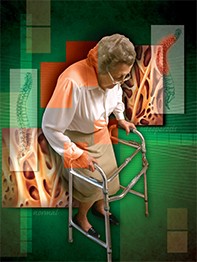Peer Reviewed
Feature Article Endocrinology and metabolism
Osteoporosis in older people: reducing risk of falls and fractures
Abstract
People over 70 years of age have an increased risk of fragility fractures and adverse outcomes and benefit most from treatment; however, they are often poorly assessed and undertreated. Management is multifactorial, and the patient’s comorbidities and life expectancy should be considered before initiating therapy and the need for ongoing treatment regularly revisited. Reducing risk of falls and fractures will have a direct impact on a patient’s morbidity and mortality.
Key Points
- Osteoporosis is a disease associated with significant morbidity, mortality and healthcare costs and its prevalence will rise significantly with our ageing population.
- All patients over the age of 70 years should be viewed as high risk and investigated appropriately with validated risk assessment tools and/or bone mineral density scans.
- Simple lifestyle changes and falls prevention measures need to be addressed alongside osteoporosis management.
- Several pharmacological options have been shown to be effective in reducing future fracture risk in people aged over 70 years and to be well tolerated in this age group.
- Reducing fracture risk will have a direct impact on morbidity, mortality and economic costs associated with osteoporosis.
Picture credit: © 2014, This image has been reprinted courtesy of Merion Matters, all rights reserved.
Purchase the PDF version of this article
Already a subscriber? Login here.

